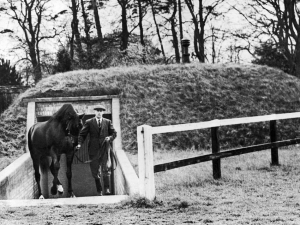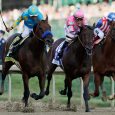By Maryjean Wall
But for one savvy bookmaker, a bomb shelter, and a smart horse who knew to get himself inside when he heard an air raid approaching, we might not have had Northern Dancer. Or Triple Crown winners Secretariat, Seattle Slew, Justify, and many other American and international racing greats.
For this strange tale of the turf we need to go back to Europe when it was becoming greatly unsettled with the rise of Italian fascism, the growing power of German Nazis, and the arms buildup and land grabs that led to World War II. This was the world of Nearco, a black thoroughbred foaled in 1935 in Italy at the farm of his primary breeder, Federico Tesio.

Photo from Wikipedia
Nearco was a wonder. He raced through an undefeated career of 14 starts, including the 1938 derby in Italy, a 1 1/2 mile race known as the Gran Premio del Re. For his final race, Tesio sent Nearco to France, receiving permission from notorious Italian dictator Benito Mussolini to take the horse out of the country for the Grand Prix de Paris.
Imagine the scene at Longchamp: France was on edge, with war on the horizon. Striding onto the racecourse was a black colt from fascist Italy that many in the crowd saw as representing the blackness of fascism itself. The French crowd hissed at Nearco. He won anyway.
Four days after the race at Longchamp, Tesio sold Nearco to a bookmaker in England, Martin Benson. Tesio might have been concerned with the war looming but his general practice was not to return his racing colts home: he did not want to breed his mares solely to his own stock.
Benson was a good choice to receive the horse, as he could afford to buy Nearco. Benson operated his highly successful betting business under the name Douglas Stuart and his horse breeding at Newmarket as Beech House Stud. His popular mantra from his bookmaking business was “Duggie never owes” and he meant it.
In the UK, Duggie had acquired a gold mine in Nearco. He stood the young stallion for 60,000 pounds, about $78,664 in today’s US dollars. Nearco began throwing top racehorses from the start.
But war came to England as well as the Continent. The 1940 Battle of Britain set off a bombing blitz by the German Luftwaffe that continued through the war. Londoners sent their children to the countryside for safety while Duggie sent Nearco to South Wales. But the Germans went after the iron ore and the shipping docks at Cardiff so that plan did not work out.
Nearco was returned from Wales to Beech House Stud where our man Duggie proved a man of influence: he acquired the free labor of German prisoners of war to build Nearco an underground bomb shelter in the horse’s Newmarket paddock.
The underground shelter was made of concrete and quite roomy for a horse. A rare historic photograph from 1941, titled “All Clear,” shows Nearco being led back outside from his shelter following an air raid. The story was the horse knew to go inside on his own whenever he heard the sirens.
That probably was the result of groom Ernie “Bogey” Lee’s influence. Nearco had gone through 10 grooms in his first 10 months at Beech House Stud before Lee became his permanent handler. Nearco’s personality was so difficult that no other stud grooms could work with him. Nearco refused to be handled. He wanted to eat his grooms rather than submit to their care.
Duggie prevailed on Lee to the rescue and in Lee’s hands, Nearco became like a puppy, according to the horse’s story told by Colin Nolte in an article, “Nearco: Tesio’s First Masterpiece.” But he was a puppy only in Lee’s hands. Nearco remained a dangerously aggressive stallion whenever anyone else approached. He did not want to see any human other than Lee.

Photo was taken by the famous equestrian photographer Anscomb.
This was recounted by another stud groom at Beech House, Michael McFarling, quoted in Classic Lines by Richard Stone Reeves and Patrick Robinson: “Old Ernie had a way with Nearco,” McFarling said. “They thought the world of each other. When it was time for Nearco to go to the breeding shed, Ernie would lead him around on a loose lead singing to him in a French accent, ‘Thank heaven for little girls…’ But it was dangerous for anyone to get near him without Ernie.”
Lee’s most invaluable service to thoroughbred racing was his taming of Nearco and teaching the horse to walk into the bomb shelter on his own and stay there until Lee led him back out.
Nearco’s first year at stud spoke to the influence he would have on the international turf. Among his foals born that year was Nasrullah, who, imported from Ireland to stand at Kentucky’s Claiborne Farm a decade later, sired horses that would figure significantly on both sides of the Atlantic. Through one son of Nasrullah, Bold Ruler, came Secretariat.
Another son of Nearco was Nearctic, bred in England and foaled in Canada in 1954 at E. P. Taylor’s Windfields Farm. Nearctic was the 1958 Canadian Horse of the Year but perhaps his most memorable imprint on racing was his son, Northern Dancer, winner of two legs of the American Triple Crown and the most sought-after sire of the 20th Century.
Sunday Silence, 1989 Kentucky Derby winner, came through the line established by another Nearco son, Royal Charger. American Triple Crown winner Justify has crosses of both Nearco and Nasrullah. Information supplied by France Galop shows that the male bloodline of every Prix de l’Arc de Triomphe winner from 1994 through 2009 leads to Nearco, his son Nasrullah, and his grandson Northern Dancer. Abram Hewitt in his seminal book, Sire Lines, called Nearco a cornerstone on which the thoroughbred breed was built.
Nearco died at age 22 at Beech House Stud in June 1957. He had been champion sire in England twice and for 16 consecutive years was among the top 10 sires. Towards the end of his life he suffered from cancer in one hip. This made it difficult for him to get up and down. He also suffered digestive problems. Lee hand-fed him a mix of hay and grain for the last few months of his life and one day, when they got the horse to his feet, led him to a nearby research station where the aging horse was euthanized. Lee retired from Beech House Stud that day and never worked with horses again.



